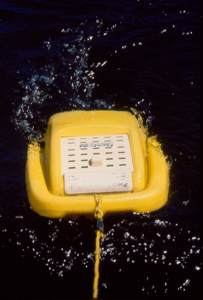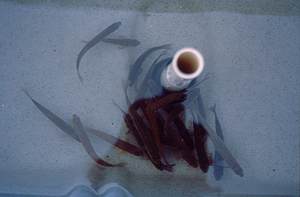|
Keeping Minnows in Fish-Catching Condition
By
Tim Allard
As anglers many of us are guilty of anxiously rushing to our
favorite spot for a day of fishing. The thrill of anticipation is
one of the things I enjoy most about fishing; however, it's
disheartening when your pre-fishing haste is because you're trying
to get to the water before all your minnows go belly-up. Healthy,
live bait can be crucial to fishing success, especially in tough
conditions or when targeting finicky feeders like walleye. Here are
some tips on transporting minnows and how-to keep them in
fish-catching condition.

Flow-though bait buckets are great for storing minnows when
surface water temperatures are cool to warm, yet in the dog days of
summer place a bucket of minnows in a cooler with ice packs to keep
them healthy.
Buy Quality Bait
How long your minnows stay alive once you purchase them begins with
the quality of bait you buy. If you have the time, check a few bait
shops to get the best quality bait you can find. Don't be afraid to
ask them when their shipments come and how long the bait's been kept
in the store. Knowing the delivery times allows you to stock-up for
a few days of fishing, but also lets you get the minnows while their
in peak condition. When choosing minnows, they should group tightly
together in the tank. Disoriented and loosely grouped balls of bait
are signs of weak minnows. If you're lucky enough to be able to pick
your minnows individually, look for them to have strong colors and
no signs of marks or cuts on their sides. Holding tanks in bait
shops vary, some can be quite decent while others can decrease
minnows' vigor. It's worth your effort to befriend local tackle shop
owners, not only will you be able to keep track on the freshest
bait, but you might get tips on what the fish are biting on.
Tips for Transportation
Getting minnows from the bait shop to your destination can appear to
be a race against time for the unprepared; yet investing in the
proper gear will allow you to leisurely drive to your favorite
fishing spot. Most bait shops will provide minnows in a plastic bag
if you don't have a container and some will also inflate the bag
with oxygen. The bag may work for short trips in mild temperatures,
but for long rides on hot days you're better off with a minnow
bucket with a portable, battery powered aerator. In hot temperatures
consider keeping the bucket in a cooler with some ice packs to keep
the water temperature at a reasonable level. This bucket and cooler
system is also effective when fishing and surface water temperatures
are too warm to use a flow-through minnow container.

Healthy minnows will stay in a tight ball, or school, like the
ones pictured here in a livewell.
Minnows in the Boat
Many mid- to high-end fishing boats have built-in baitwells or
livewells for storing minnows. Some baitwell models have a separate
system that allows you to store an actual bucket inside the well,
while livewells can feature a divider to store bait and caught fish
at the same time. Both wells keep the water oxygenated through a
pump system. Most live wells are somewhat insulated and protected
from direct sunlight to reduce their heat absorption on hot days,
but it's a good idea to bring small ice packs or cubes to leave in
the well to keep the water temperature down.
Keeping them at Home
Keeping minnows at home is as simple as having pet fish, as long as
you have the basic equipment. I keep my bait in an old aquarium in
my basement. The area is cool, which helps keep bait comfortable. I
use an aquarium filter to keep the water clean and oxygenated. I
also have an air stone and electric pump to add additional oxygen if
I have a lot of bait in the tank. When keeping minnows for a long
period of time (several weeks for example), resist the urge to feed
them too much. You can pick up some generic fish food at a pet
store, and a few flakes now a then will keep them healthy. Like pet
fish, feed minnows just enough food for them to eat in a few
minutes. If food is floating on the surface after five, you've fed
them too much. It's also important to change the water occasionally
by replacing no more than a quarter or a third of the tank at a
time. This reduces the temperature or PH from changing too much and
shocking the fish. Also ensure the water isn't chlorinated. Finally,
keep your aquarium completely covered. I use a mesh, screen fixed to
a square of wood that sits directly over the tank top. Generic
aquarium tops will not prevent the escapes of resourceful minnows,
resulting in dead minnows on the floor. A sight that could get your
bait tank quickly ousted out of the house by your family.
A final important note on using minnows as bait is only use bait
taken from the same water body you are fishing. Transporting minnows
and bucket water to new lakes and rivers can spread evasive species,
such as zebra muscles, spiny water fleas or eurasian watermilfoil to
name a few. It's a money-saver to learn how-to keep minnows alive
during transport, but if you're unsure the contents of your bait
bucket are native to the water body your fishing, it's a small cost
to buy a few dozen minnows from a local bait shop, than risk ruining
a fishery.
|